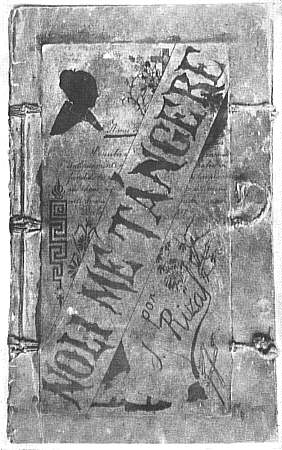|
Florentino Collantes
Florentino Collantes (October 16, 1896 – July 15, 1951) was a Filipino poet who was among the writers who spearheaded a revival of interest in Tagalog literature in the Philippines in the 20th century. Early years Collantes was born in the village of Dampol in Pulilan, Bulacan to Toribio Collantes of Baliwag, Bulacan and Manuela Tancioco of Pulilan. He completed his primary and secondary schooling in Malolos, Bulacan. As a teenager, Collantes displayed an avid interest in literature and memorized epic poems in Spanish () and Tagalog (). He is known to have committed to memory long excerpts from versified stories on the passion of Jesus Christ, known as 'pasion', that are traditionally sung in public during Holy Week in the Philippines. He was also a skilled practitioner of 'duplo', or a dramatic poetical joust that was a popular form of entertainment in the Philippines until the 1950s. At the age of 15, he already read almost all (), ('dula') and . Due to poverty, he only manages ... [...More Info...] [...Related Items...] OR: [Wikipedia] [Google] [Baidu] |
Filipino People
Filipinos ( tl, Mga Pilipino) are the people who are citizens of or native to the Philippines. The majority of Filipinos today come from various Austronesian ethnolinguistic groups, all typically speaking either Filipino, English and/or other Philippine languages. Currently, there are more than 185 ethnolinguistic groups in the Philippines; each with its own language, identity, culture and history. Names The name ''Filipino'', as a demonym, was derived from the term ''Las Islas Filipinas'' ("the Philippine Islands"), the name given to the archipelago in 1543 by the Spanish explorer and Dominican priest Ruy López de Villalobos, in honor of Philip II of Spain (Spanish: ''Felipe II''). During the Spanish colonial period, natives of the Philippine islands were usually known by the generic terms ''indio'' ("Indian") or ''indigenta'' ("indigents"). However, during the early Spanish colonial period the term ''Filipinos'' or ''Philipinos'' was sometimes used by Spanish writers ... [...More Info...] [...Related Items...] OR: [Wikipedia] [Google] [Baidu] |
Writers From Bulacan
A writer is a person who uses written words in different writing styles and techniques to communicate ideas. Writers produce different forms of literary art and creative writing such as novels, short stories, books, poetry, travelogues, plays, screenplays, teleplays, songs, and essays as well as other reports and news articles that may be of interest to the general public. Writers' texts are published across a wide range of media. Skilled writers who are able to use language to express ideas well, often contribute significantly to the cultural content of a society. The term "writer" is also used elsewhere in the arts and music, such as songwriter or a screenwriter, but also a stand-alone "writer" typically refers to the creation of written language. Some writers work from an oral tradition. Writers can produce material across a number of genres, fictional or non-fictional. Other writers use multiple media such as graphics or illustration to enhance the communication of t ... [...More Info...] [...Related Items...] OR: [Wikipedia] [Google] [Baidu] |
History Of The Philippines
Earliest hominin activity in the Philippine archipelago is dated back to at least 709,000 years ago. ''Homo luzonensis'', a species of archaic humans, was present on the island of Luzon at least 67,000 years ago. The earliest known anatomically modern human was from Tabon Caves in Palawan dating about 47,000 years. Negrito groups were the first inhabitants to settle in the prehistoric Philippines. By around 3000 BC, seafaring Austronesians, who form the majority of the current population, migrated southward from Taiwan. Scholars generally believe that these ethnic and social groups eventually developed into various settlements or polities with varying degrees of economic specialization, social stratification, and political organization. Some of these settlements (mostly those located on major river deltas) achieved such a scale of social complexity that some scholars believe they should be considered early states. This includes the predecessors of modern-day population centers ... [...More Info...] [...Related Items...] OR: [Wikipedia] [Google] [Baidu] |
Literature Of The Philippines
Philippine literature is literature associated with the Philippines from prehistory, through its colonial legacies, and on to the present. Pre-Hispanic Philippine literature was actually epics passed on from generation to generation, originally through an oral tradition. However, wealthy families, especially in Mindanao, were able to keep transcribed copies of these epics as family heirloom. One such was the ''Darangen'', an epic of the Maranaos. Classical literature in Spanish during the 19th Century On December 1, 1846, the first daily newspaper, '' La Esperanza'', was published in the country. Other early newspapers were ''La Estrella'' (1847), '' Diario de Manila'' (1848) and ''Boletin Oficial de Filipinas'' (1852). The first provincial newspaper was ''El Eco de Vigan'' (1884), which was issued in Ilocos. In Cebu City, ''El Boleaetín de Cebú'' (The Bulletin of Cebu) was published in 1890. On 1863, the Spanish government introduced a system of free public educ ... [...More Info...] [...Related Items...] OR: [Wikipedia] [Google] [Baidu] |
Pag-ibig At Awa
The Home Development Mutual Fund (HDMF), commonly known as the Pag-IBIG ( Pagtutulungan sa Kinabukasan, Ikaw, Bangko, Industriya at Gobyerno) Fund, is a government-owned and controlled corporation under the Department of Human Settlements and Urban Development of the Philippines responsible for the administration of the national savings program and affordable shelter financing for Filipinos. History Pag-IBIG Fund was founded by virtue of Presidential Decree No. 1530 which was signed by President Ferdinand E. Marcos on June 11, 1978, to answer the national need for savings program and affordable housing financing. Its original purpose was solely as a provident fund to encourage savings among Filipinos. By March 1979, the fund was administered by the National Home Mortgage Finance Corporation (NHMFC), a government corporation mandated to increase availability of housing loans to Filipino workers. By June, HDMF was implemented by virtue of Executive Order No. 538. Emily Abinoj ... [...More Info...] [...Related Items...] OR: [Wikipedia] [Google] [Baidu] |

